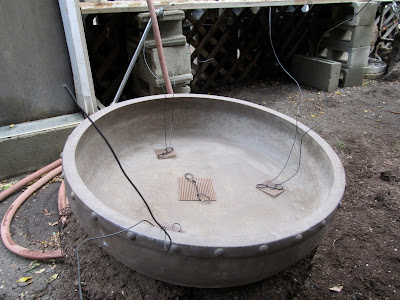Recently my wife and I made a trip to the Olympic Peninsula in Washington and we were awed by the majesty of the place. ( See here for the story http://bonsaibpsbonsaiblog-bonsai.blogspot.com/2011_11_06_archive.html )
I was inspired to recreate some of what I saw in bonsai so to that end I went searching through the nursery. Here is what I found- it's a 16' tall Atlas Cedar in a 24" tub.
First I had to cut the top off so we could bring it through the nursery without hitting the shade cloth or the ceiling of the breezeway.
What I want to create is a tree that invokes the feeling of strength and perseverance like one gets when seeing a tree high up in the tree line battered by everything mother nature can throw at it. It may have been struck by lightening, had most of its branches broken under the weight of countless winter snow storms, maybe even hit by a rockslide but still it grows on.
Many trees high up on the mountain have slim ,fairly straight trunks with minimal foliage due to the adverse growing conditions. For me they are some of the most impressive trees because they have survived for sometimes centuries in some of the harshest condition to grow in.
To start I decided that I wanted the top to be a jin- maybe like a tree struck by lightening or one the had the top snapped off in a windstorm. To do this I removed most of the upper branches and peeled the bark from the trunk and the two remaining top branches. I did this by using a branch splitter to split the trunk in several places and then used pliers to twist and tear the pieces off which left a twisted natural looking jin on the top.
To determine what the front was going to be I had to check the nebari or base of the tree.
There were a lot of old crossing roots that I removed. It was also planted deeper than it needed to be and once I got it all cleaned up I was pleasantly surprised to find a decent base on the tree.
Once I had the front determined it was time to figure out the rest of the tree.
Since these trees grow under such extreme conditions they don't usually have a lot of foliage mass. I knew I wanted a tree with a minimal amount of foliage so I started pruning-alot. I probably took off 80% of the original foliage.
After pruning I had to wire all the branches into the positions I wanted them. To do this I used various gauges of aluminum wire, some raffia to protect the branches and a few guy wires.
Now its time to reduce the rootball. I was planning on at least two transplantings to get it small enough to put in an appropriate pot. The root ball was so big and so packed with roots I needed power tools to do the initial reduction. This is a 24' high by 24' round solid mass of roots.
Much to my surprise I found the rootball to be filled from top to bottom with really fine roots. So many that I was able to safely do a much bigger reduction than I originally thought I could.
I had to trim a few bigger roots on the bottom but was amazed at the number and health of feeder roots throughout the root mass.
This presented a little bit of a dilemma as I was planning on putting it into a training pot not a bonsai pot. So After a search through our pot inventory I found this handmade Chinese drum pot that I thought would be appropriate.
So just a little more trimming around the edge of the roots and it fit just as if I had planned it.
Here is the finished tree. I will let the existing branches get fuller but I won't allow any additional branches to grow. I really want this tree to make a statement and once it fills out a bit I'm pretty sure it will.It's definitely taller than most bonsai at 55" but I think this tree will be able to pull that off.
In the future I may plant the tree in a stone similar to this to really enhance the idea that it's growing in the mountains.
Well that's it for todays subject. I hope you enjoyed it. I welcome any comments or suggestions.













Looks beautiful - can't wait to see it in person!
ReplyDeleteThanks, It's even better in person.
ReplyDeleteVery good interest to read.
ReplyDelete